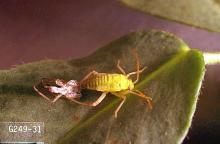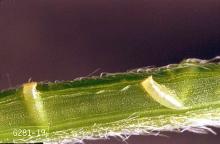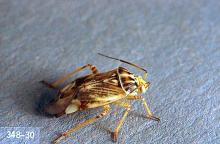Lygus spp.
Pest description, crop damage and life history
See:
Common Pests of Vegetable Crops
Pest monitoring Sweep nets can be used to sample for lygus bugs. In the Pacific Northwest, a suggested treatment threshold is 0.5 adult or 0.5 fourth or fifth instar per sweep. In California, for dry beans, treatment thresholds vary depending on the variety and the stage of the crop, from 0.5 to 2 lygus bugs per sweep.
Management-biological control
Generalist predators, such as lacewings and damsel bugs, may prey on lygus bug nymphs. Parasitic wasps may also prey on lygus such as Peristenus spp. Conserve populations of these biological control agents by minimizing applications of broad-spectrum insecticides.
Management-cultural control
Lygus bugs are likely to move when other food sources become unsuitable. Common weeds that are good hosts of lygus bugs include pigweed and wild radish.
Mowed alfalfa fields nearby are commonly a source of large numbers of lygus bug adults. There are a number of practices to reduce or control the movement of adults from alfalfa into nearby bean fields. These techniques leave uncut, tall alfalfa (attractive to lygus bug adults) within or near the cut area.
Management-chemical control: HOME USE
Follow information given on the label about the timing and cutoff date for the particular vegetable you are spraying.
- azadirachtin (combined with pyrethrins)-Some formulations are OMRI-listed for organic use.
- bifenthrin (usually combined with zetacyermethrin)
- carbaryl
- plant essential oils (rosemary, etc.)-Some formulations are OMRI-listed for organic use.
- pyrethrins (often combined with other ingredients)-Some formulations are OMRI-listed for organic use.
- zeta-cypermethrin
Management-chemical control: COMMERCIAL USE
- beta-cyfluthrin (Baythroid XL) at 0.019 to 0.025 lb ai/A. PHI 7 days. REI 12 hr. Do not exceed 0.05 lb ai/A per season. Do not feed treated vines or hay to livestock.
- dimethoate (numerous products) at 0.25 to 0.5 lb ai/A. PHI 0 days when harvested mechanically. REI 48 hr. Do not feed treated vines.
- lambda-cyhalothrin (Warrior II) at 0.02 to 0.03 lb ai/A. PHI 7 days for green beans, 21 days for dry beans. REI 24 hr. Do not feed or graze livestock. Do not exceed 0.12 lb ai/A per year. Do not apply within 25 ft of an aquatic habitat, 150 ft if applied by air.
- malathion (numerous products) at 1.5 lb ai/A. PHI 1 day. REI 12 hr. Do not graze or feed foliage to livestock.
- methomyl (Lannate LV) at 0.45 to 0.9 lb ai/A. PHI 1 to 3 days for succulent beans, 14 days for dry beans, 3 days for feeding vines, 7 days for hay. REI 48 hr. Do not exceed 4.5 lb ai/A per year.
- naled (Dibrom 8) at 0.94 lb ai/A. PHI 1 day. REI 48 hr. Do not apply within 25 ft of an aquatic habitat, 150 ft if applied by air.
- phorate (Thimet 20-G)-Do not exceed 1.5 lb ai/A. PHI 60 days. REI 48 hr, or 72 hr if annual rainfall is less than 25 inches. Apply at planting. Do not graze or feed to livestock. Toxic to fish and wildlife.
- sufloxaflor (Transform WG) at 0.75 to 1.0 oz/A. Do not exceed 8.5 oz/A. PHI 7 days. REI 24 hr. If blooming vegetation is present 12 out from the downwind edge of the field, a 12 foot in-field down wind buffer must be observed.



